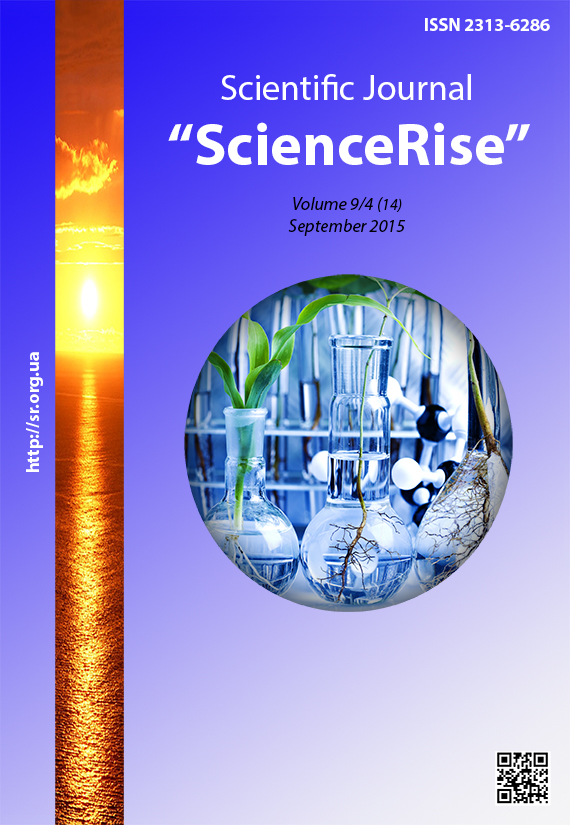Оценка основных методов диагностики для выявления атрофии зрительных нервов
DOI:
https://doi.org/10.15587/2313-8416.2015.50137Słowa kluczowe:
зрительный нерв, атрофия, диагностика, специфичность, чувствительность, точностьAbstrakt
Изучались методы диагностики восходящей и нисходящей атрофии зрительных нервов (АЗН). Выявлено, что максимальные показатели исследуемых параметров при восходящей АЗН отмечается у HRT(Хейдельбергская ретинальная томография) исследования. При нисходящей АЗН наиболее результативными исследуемые параметры выявлены у компьютеной периметрии и ЗВП (зрительные вызванные потенциалы)
Bibliografia
Bourne, R., Price, H., Stevens, G. et. al (2012). Global Burden of Visual Impairment and Blindness. Archives of Ophthalmology, 130 (5). doi: 10.1001/archophthalmol.2012.1032
Morozov, V. I., Yakovlev, A. A. (2010). Zhabolevania zritelnogo puti [Diseases of the visual pathway]. Moscow: Binom, 650.
Prasad, S., Volpe, N. J., Balcer, L. J. (2010). Approach to optic neuropathies: clinical update. Neurologist, 16 (1), 23–24.
Motileva, V. A. (2013). Sovremennie metodi chastichnoi atrofiizritelnogo nerva razlichnogo geneza [Modern methods of diagnosis of partial atrophy of the optic nerve of various origins]. Bulletin health Internet conferences, 2, 306.
Pineles, S. L., Volpe, N. J., Miller-Ellis, E., Galetta, S. L., Sankar, P. S., Shindler, K. S. et. al (2006). Automated Combined Kinetic and Static Perimetry. Archives of Ophthalmolog, 124 (3), 363. doi: 10.1001/archopht.124.3.363
Shuko, A. G., Malisheva, V. V. (Eds.) (2010). Opticheskaya kogerentnaya tomografia v diagnostike glaznich boleznei [Optical coherence tomography in diagnosing ophthalmic diseases]. Moscow: HEOTAR-Media, 126.
Kanukov, V. N., Ponomarev, I. V., Korolkova, M. S. (2009). Opticheskaya koherentnaya tomografia v diagnostike patolohicheskih sostoyanii glaznoho dna [Optical coherence tomography in the diagnosis of pathological conditions of the fundus]. Bulletin of the Orenburg State Medical University, 12, 59–61.
Al Wadani, F., Khandekar, R., Asbali, T., Gigan, S. (2012). Review of retinal morphology around optic disc in Peripapillary atrophy by using Spectralis Optical Coherent Tomography. Oman Journal of Ophthalmology, 5 (3), 204. doi: 10.4103/0974-620x.106111
Pianta, M. J. (2008). A more coherent relationship between optical coherence tomography scans and retinal anatomy. Clinical and Experimental Optometry, 91 (3), 327–328. doi: 10.1111/j.1444-0938.2008.00265.x
Meyer, C. H., Sekundo, W. (2004). Evaluation of Granular Corneal Dystrophy With Optical Coherent Tomography. Cornea, 23 (3), 270–271. doi: 10.1097/00003226-200404000-00009
Norcia, A. M. (2013). Linking perception to neural activity as measured by visual evoked potentials. Visual Neuroscience, 30 (5-6), 223–227. doi: 10.1017/s0952523813000205
Hnezdinski, V. V., Korepina, O. S. (2011). Atlas po vizvannim potencialam mozga (prakticheskoe rukovodstvo, osnovannoe na analize konkretnih klinicheskih nabludeniy [Atlas of evoked potentials (practical guidance based on the analysis of specific clinical observations]. Ivanovo: PresSto, 528.
Fraser, C., Klistorner, A., Graham, S., Garrick, R., Billson, F., Grigg, J. (2006). Multifocal Visual Evoked Potential Analysis of Inflammatory or Demyelinating Optic Neuritis. Ophthalmology, 113 (2), 315–323. doi: 10.1016/j.ophtha.2005.10.017
Moskalenko, V. F., Gul'chij, O. P., Lytvynova, L. O., Decyk, O. Z., Kol'cova, N. I., Moskalenka, V. F. (Ed.) (2010). Socialnaya hihiena i organizacia ohoroni zdorovia [Social hygiene and public health]. Kyiv: Kniga plus, 328.
##submission.downloads##
Opublikowane
Numer
Dział
Licencja
Copyright (c) 2015 Вера Анатольевна Васюта

Utwór dostępny jest na licencji Creative Commons Uznanie autorstwa 4.0 Międzynarodowe.
Our journal abides by the Creative Commons CC BY copyright rights and permissions for open access journals.
Authors, who are published in this journal, agree to the following conditions:
1. The authors reserve the right to authorship of the work and pass the first publication right of this work to the journal under the terms of a Creative Commons CC BY, which allows others to freely distribute the published research with the obligatory reference to the authors of the original work and the first publication of the work in this journal.
2. The authors have the right to conclude separate supplement agreements that relate to non-exclusive work distribution in the form in which it has been published by the journal (for example, to upload the work to the online storage of the journal or publish it as part of a monograph), provided that the reference to the first publication of the work in this journal is included.

